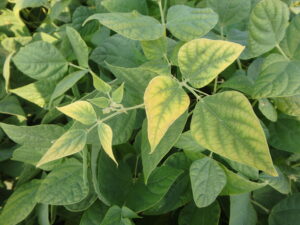Phosphate and potash recommendations for dry edible beans are presented below in the tables below. Where soil fertility levels are adequate, dry edible beans show minimal response to starter phosphorous. Where potassium fertility is low, deficiency symptoms appear in white beans as yellowing of the lower leaves and necrosis on leaf margins. Dry edible bean seedlings are very sensitive to ammonia toxicity and salt damage from starter fertilizer. No fertilizer should be placed in direct contact with the seed. Band starter fertilizer 5 cm (2 in.) to the side and 5 cm (2 in.) below the seed. Banding is a more efficient method of applying phosphorus or zinc when they are required. Fertilizer may be broadcast and plowed down, worked in before planting or applied through a planter that has a separate attachment for fertilizer.
More information on fertility can be found in OMAFRA Publication 811, Agronomy Guide for Field Crops.
Table 1. Phosphate (P2O5) guidelines for dry edible beans
| Sodium bicarbonate phosphorus soil test | Phosphate required |
| 0-3 ppm | 80 kg/ha (HR, high response) |
| 4-5 ppm | 60 kg/ha (HR) |
| 6-7 ppm | 50 kg/ha (HR) |
| 8-9 ppm | 40 kg/ha (HR) |
| 10-12 ppm | 30 kg/ha (MR, medium response) |
| 13-15 ppm | 20 kg/ha (MR) |
| 16-30 ppm | 0 (LR, low response) |
| 31-60 ppm | 0 (RR, rare response) |
| 61 ppm + | 0 (NR, no response)* |
| *When the response rating for a nutrient is NR, application of phosphorus in fertilizer or manure may reduce crop yield or quality. For example, phosphorus applications may induce zinc deficiency on soils low in zinc and may increase the risk of water pollution. | |
| Based on OMAFRA-accredited soil tests. Profitable response to applied nutrients occurs when the increase in crop value, from increased yield or quality, is greater than the cost of the applied nutrient. When manure is applied, reduce the fertilizer application according to the amount and quality of manure (Chapter 9, Manure section). | |
Table 2. Potash (K2O) guidelines for dry edible beans
| Ammonium acetate potassium soil test | Potash required |
| 0-15 ppm | 120 kg/ha (HR) |
| 16-30 ppm | 110 kg/ha (HR) |
| 31-45 ppm | 90 kg/ha (HR) |
| 46-60 ppm | 80 kg/ha (HR) |
| 61-80 ppm | 60 kg/ha (MR) |
| 81-100 ppm | 40 kg/ha (MR) |
| 101-120 ppm | 30 kg/ha (MR) |
| 121-150 ppm | 0 (LR) |
| 151-250 ppm | 0 (RR) |
| 251 ppm + | 0 (NR*) |
| * When the response rating for a nutrient is NR, application of potash in fertilizer or manure may reduce crop yield or quality. For example, potash application on soils low in magnesium may induce magnesium deficiency. | |
| Based on OMAFRA-accredited soil tests. Profitable response to applied nutrients occurs when the increase in crop value, from increased yield or quality, is greater than the cost of the applied nutrient. When manure is applied, reduce the fertilizer application according to the amount and quality of manure (Chapter 9, Manure section). | |
Only use these tables with OMAFRA accredited soil tests. Non-accredited tests may use extractants that pull out different amounts of nutrient so they will not give correct values if used with the published OMAFRA tables.

